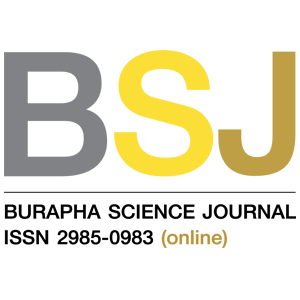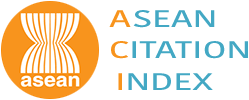ความชุกชุมของปูลม (Ocypode spp.) การย้ายเขตที่อยู่อาศัย และพฤติกรรมการขุดรูตอบสนองต่อนักท่องเที่ยวและความผันแปรของอุณหภูมิ ในหาดทรายบนเกาะเต่า จังหวัดสุราษฎร์ธานี
คำสำคัญ:
ปูลม, เกาะเต่า, หาดอ่าวโฉลกบ้านเก่า , การคุกคามของมนุษย์ , การเปลี่ยนแปลงสภาพภูมิอากาศบทคัดย่อ
วัตถุประสงค์และที่มา : เกาะเต่าเป็นแหล่งท่องเที่ยวระดับโลก หาดทรายบนเกาะเต่าเป็นบริเวณที่มีการพัฒนาสิ่งก่อสร้างเพื่อรองรับการท่องเที่ยว และมีนักท่องเที่ยวจำนวนมาก ประกอบกับเป็นบริเวณที่มีการแปรผันของอุณหภูมิ จึงมีโอกาสเกิดการคุกคามความหลากหลายทางชีวภาพได้ โดยปูลมเป็นสัตว์ทะเลกลุ่มหนึ่งที่พบชุกชุมบนหาดทรายและได้รับผลกระทบจากการคุกคามโดยมนุษย์มากที่สุด การศึกษานี้ทำการศึกษาภายใต้หาดเดียวกันที่แบ่งเป็น 4 เขตที่มีจำนวนนักท่องเที่ยวและอุณหภูมิที่แตกต่างกัน ซึ่งปูลมในแต่ละเขตน่าจะมีการตอบสนองแตกต่างกัน ได้แก่ ความชุกชุม การย้ายเขตที่อยู่อาศัย และพฤติกรรมการขุดรู โดยรูปูใช้เป็นที่อยู่อาศัย หลบภัยจากการล่า การคุกคามจากมนุษย์ สภาวะแห้ง และการเปลี่ยนแปลงของอุณหภูมิ สะท้อนถึงความเป็นอยู่ของปูลมที่เปลี่ยนแปลงไปภายใต้สภาพแวดล้อมที่แตกต่างกัน การศึกษานี้มีวัตถุประสงค์เพื่อพัฒนาปูลมเป็นตัวชี้วัดการสูญเสียแหล่งที่อยู่อาศัยจากนักท่องเที่ยวและการผันแปรของอุณหภูมิในหาดทราย เพื่อการจัดการและอนุรักษ์ทรัพยากรทางทะเลและชายฝั่งของประเทศไทย
วิธีดำเนินการวิจัย : ทำการศึกษาที่หาดอ่าวโฉลกบ้านเก่า เกาะเต่า จังหวัดสุราษฎร์ธานี (ละติจูด 10°04'01''N, ลองจิจูด 99°49'33''E) ซึ่งมีนักท่องเที่ยวจำนวนมาก และมีการสร้างแนวกันคลื่นด้วยซีเมนต์ที่ด้านบนสุดของหาดติดกับแนวบ้านพัก วางแนวสำรวจและเก็บตัวอย่างแบ่งเป็น 4 เขตจากแนวกันคลื่น ได้แก่ เขตตอนบนของเขตน้ำขึ้นสูงสุด (A) เขตตอนล่างของเขตน้ำขึ้นสูงสุด (B) เขตตอนบนของเขตน้ำขึ้นน้ำลง (C) และเขตตอนล่างของเขตน้ำขึ้นน้ำลง (D) เแต่ละเขตห่างกัน 1 เมตร สุ่มนับจำนวนรูปูลมโดยใช้ตารางสุ่มสัตว์ (quadrat) ซึ่งใช้เชือกขนาด 1x5 เมตร วางแนวสำรวจรวม 8 แนวเก็บตัวอย่าง โดยมีสถานีสำรวจรวมทั้งสิ้น 32 สถานี ศึกษาชนิดปูลม ความชุกชุมของรูปู ขนาดรูปู ความลึกของรูปู และรูปร่างรูปู ตรวจวัดอุณหภูมิอากาศ อุณหภูมิทรายภายนอกและภายในรูในเขตต่าง ๆ บนหาด มีการประเมินจำนวนนักท่องเที่ยวที่พบในเขตต่าง ๆ บนหาด รวมทั้งตรวจวัดคุณภาพสิ่งแวดล้อมและคุณภาพน้ำ ได้แก่ ความลาดชัน ขนาดตะกอนทราย ปริมาณอินทรีย์สาร ความชื้น ความดังของเสียง อุณหภูมิน้ำ ความเค็ม ความเป็นกรดเป็นด่าง ปริมาณออกซิเจนละลายน้ำ และคลื่นลม
ผลการวิจัย : หาดอ่าวโฉลกบ้านเก่าเป็นหาดทรายที่มีความลาดชันต่ำ มีขนาดตะกอนทรายเป็นแบบทรายหยาบมีปริมาณอินทรีย์สารเฉลี่ยร้อยละ 1.52 พบปูลม 2 ชนิด คือ ปูลมก้ามเรียบ (Ocypode cordimanus Latreille, 1818) ซึ่งเป็นชนิดเด่น และปูลมก้านตายาว (Ocypode ceratophthalma (Pallas, 1772)) ปูลมในเขตต่าง ๆ 4 เขตตอบสนองต่อนักท่องเที่ยวและการผันแปรของอุณหภูมิ โดยมีความชุกชุม ขนาดของรูปู และความลึกของรูปูแตกต่างกันอย่างมีนัยสำคัญทางสถิติ (p<0.05) โดยปูลมที่อยู่ในเขตตอนบนของเขตน้ำขึ้นน้ำลง (C) ซึ่งเป็นแนวพักผ่อนและสัญจรของนักท่องเที่ยว มีความชุกชุมต่ำ (0.25±0.16 รูต่อตารางเมตร) มีขนาดรูใหญ่ (20.43±10.22 มิลลิเมตร) มีการขุดรูที่ลึกที่สุด (13.97±6.77 เซนติเมตร) และมีรูปร่างรูแตกแขนงและซับซ้อนกว่าเขตอื่น ๆ ส่วนปูลมขนาดใหญ่มีการย้ายเขตที่อยู่อาศัยขึ้นไปอาศัยอยู่เขตตอนบนของเขตน้ำขึ้นสูงสุด (A) ที่ไม่มีนักท่องเที่ยวสัญจรไปมาในเขตนี้ โดยมีความชุกชุมมากที่สุด (0.75±0.40 รูต่อตารางเมตร) มีการขุดรูที่ลึกเป็นรูปตัว J ตอบสนองต่อความผันแปรของอุณหภูมิ ส่วนปูลมขนาดเล็ก (9.47±5.12 มิลลิเมตร) มีการหลีกเลี่ยงนักท่องเที่ยวลงไปอาศัยในเขตตอนล่างของเขตน้ำขึ้นน้ำลง (D) มีรูที่ลึกน้อยที่สุด (8.46±2.41 เซนติเมตร) อุณหภูมิระหว่างเขตต่าง ๆ 4 เขตไม่แตกต่างอย่างมีนัยสำคัญทางสถิติ (p>0.05) แต่อุณหภูมิอากาศ อุณหภูมิภายนอก และภายในรูปูมีความแตกต่างกันอย่างมีนัยสำคัญทางสถิติ (p<0.05) ปูลมจึงมีการตอบสนองต่อการแปรผันของอุณหภูมิโดยขุดรูที่ลึกขึ้นเพื่อหลีกเลี่ยงอุณหภูมิภายนอกรูที่สูงกว่าภายในรูปู ทั้งนี้คุณภาพน้ำในพื้นที่ศึกษาอยู่ในเกณฑ์ปกติ คือ อุณหภูมิน้ำทะเล 31.48±1.34 oC ความเค็ม 32.03±0.87 psu ความเป็นกรดเป็นด่าง 8.12±1.10 และปริมาณออกซิเจนที่ละลายน้ำ 7.05±0.51 mg/L ปูลมในหาดอ่าวโฉลกบ้านเก่าในการศึกษานี้มีการตอบสนองต่อนักท่องเที่ยวมากกว่าการผันแปรของของอุณหภูมิที่เพิ่มขึ้นในแต่ละเขต เนื่องจากการเพิ่มขึ้นของอุณหภูมิอยู่ในช่วงสั้น ๆ และมีการขึ้นลงของน้ำทะเล การตอบสนองของปูลมในเขตต่าง ๆ ในหาดเดียวกันของการศึกษานี้มีผลการศึกษาคล้ายคลึงกับการศึกษาที่ผ่านมาที่ทำการศึกษาในหาดหลายหาดที่มีระดับการคุกคามแตกต่างกัน ปูลมในหาดอ่าวโฉลกบ้านเก่าในเขตต่าง ๆ มีการตอบสนองต่อนักท่องเที่ยวและการผันแปรของอุณหภูมิ โดยมีความชุกชุมลดลง มีการเปลี่ยนเขตที่อยู่อาศัย ขุดรูลึกขึ้นและซับซ้อนขึ้นอย่างชัดเจน ดังนั้นการศึกษาปูลมภายใต้หาดอ่าวโฉลกบ้านเก่าที่มีการแบ่งเป็น 4 เขต จึงสามารถใช้บอกผลกระทบที่เกิดจากการคุกคามของนักท่องเที่ยวและการแปรผันของอุณหภูมิที่เป็นสาเหตุให้เกิดการสูญเสียแหล่งที่อยู่อาศัยของปูลมในหาดทรายได้ นอกจากนั้นจากการตรวจสอบอุณหภูมิอากาศบนเกาะเต่าระหว่างปี พ.ศ. 2565-2566 พบแนวโน้มของการเพิ่มขึ้นของอุณหภูมิสูงสุดในปี พ.ศ. 2566 มากกว่าปี พ.ศ. 2565 ดังนั้นควรมีการติดตามอย่างต่อเนื่องถึงผลของการเปลี่ยนแปลงอุณหภูมิในระยะยาว เพื่อศึกษาว่าการเปลี่ยนแปลงสภาพภูมิอากาศมีผลต่อการสูญเสียแหล่งที่อยู่อาศัยของปูลมในอนาคตอย่างไร
สรุปผลการวิจัย : ปูลมในหาดอ่าวโฉลกบ้านเก่า เกาะเต่า ที่อาศัยในเขตต่าง ๆ ที่มีนักท่องเที่ยวและการผันแปรของอุณหภูมิ มีการตอบสนองเพื่อหลบหลีกนักท่องเที่ยวและอุณหภูมิที่แตกต่างระหว่างภายนอกและภายในรูปู โดยมีความชุกชุมแตกต่างกัน มีการเปลี่ยนเขตที่อยู่อาศัย มีการขุดรูที่ลึกและซับซ้อนขึ้น การศึกษานี้ชี้ให้เห็นว่าปูลมบนหาดอ่าวโฉลกบ้านเก่ามีศักยภาพในการพัฒนาเป็นดัชนีชี้วัดผลกระทบจากการคุกคามของมนุษย์และการเปลี่ยนแปลงอุณหภูมิที่ทำให้เกิดการเปลี่ยนแปลงแหล่งที่อยู่อาศัยของปูลมในเขตต่าง ๆ ภายใต้หาดเดียวกัน
เอกสารอ้างอิง
Accuweather. (2023). Montly temperature of Koh Tao. Retrieved from https://www.accuweather. com/th/ ban-ko-tao/441653/weather-forecast/441653, 29 Sep. 2024. (in Thai)
Alaerts, L., Dobbelaere, T., Gravinese, P.M., & Hanert, E. (2022). Climate Change Will Fragment Florida Stone Crab Communities. Frontiers in Marine Science, 9, doi.org/10.3389/fmars.2022.839767.
Antia, E.E. (1989). Beach cusps and burrowing activity of crabs on a fine-grained sandy beach, Southeastern Nigeria. Journal of Coastal Research, 5, 263–270.
Asakura, A. (2021). Crustaceans in changing climate: Global warming and invasion of tropical land hermit crabs (Crustacea: Decapoda: Anomura: Coenobitidae) into temperate area in Japan. Zoology, 145, doi.org/10.1016/j.zool.2021.125893.
Barboza, C.A.M., Mattos, G., Soares-Gomes, A., Zalmon, I.R., & Costa, L.L. (2021). Low Densities of the Ghost Crab Ocypode quadrata Related to Large Scale Human Modification of Sandy Shores. Frontiers in Marine Science, 8, doi.org/10.3389/fmars.2021.589542.
Barros, B.F. (2001). Ghost crabs as a tool for rapid assessment of human impacts on exposed sandy beaches. Biological Conservation, 97(3), 399–404.
Bycroft, R., Leon, J.X., & Schoeman, D. (2019). Comparing random forests and convoluted neural networks for mapping ghost crab burrows using imagery from an unmanned aerial vehicle. Estuarine, Coastal and Shelf Science, 224, 84–93.
Chakrabarti, A. (1981). Burrow patterns of Ocypode ceratophthalma (Pallas) and their environmental significance. Journal of Palaeontology, 55, 431–441.
Chan, B.K.K., Chan, K.K.Y., & Leung, P.C.M. (2006). Burrow architecture of the ghost crab Ocypode ceratophthalma on a sandy shore in Hong Kong. Hydrobiologia, 560, 43–49.
De, C. (2005). Biophysical model of intertidal beach crab burrowing: application and significance. Ichnos, 12,11–29.
Dunbar, S.G., Coates, M., & Kay, A. (2003). Marine hermit crabs as indicators of freshwater inundation on tropical shores. Memoirs of Museum Victoria, 60(1), 27–34.
Duncan, G.A. (1986). Burrows of Ocypode quadrata (Fabricius) as related to slopes of substrate surfaces. Journal of Palaeontology, 60, 384–389.
Eshky, A.A. (1985). Aspects of the ecology, behaviour and physiology of the ghost crab Ocypode saratan (Forskål). PhD thesis. University of Glasgow.
Gilliand, S., Pechenik, J.A., & Clark, D. (2021). The effects of changes in temperature and salinity on the quality of shells selected by the hermit crab Pagurus longicarpus. Invertebrate Biology, 140(3),doi.org/10.1111/ ivb.12345.
Gül, M.R., & Griffen, B.D. (2018). Impacts of human disturbance on ghost crab burrow morphology and distribution on sandy shores. PLoS One, 13(12), e0209977.
Gül, M.R., & Griffen, B.D. (2019). Combined impacts of natural and anthropogenic disturbances on the bioindicator Ocypode quadrata (Fabricius, 1787). Journal of Experimental Marine Biology and Ecology, 519, 151185. doi.org/10.1016/j.jembe.2019.151185.
Hartnoll, R.G. (1969). Mating in the Brachyura. Crustaceana, 16, 161–181.
Hobbs, C.H., Landry, C.B., & Perry, J.E. (2008). Assessing anthropogenic and natural impacts on ghost crabs
(Ocypode quadrata) at Cape Hatteras National Seashore, North Carolina. Journal of Coastal Research, 24, 1450–1458.
Hoogsteen, M.J.J., Lantinga, E.A., Bakker, E.J., Groot, J.C.J., & Tittonell, P.A. (2015). Estimating soil organic carbon through loss on ignition: effects of ignition conditions and structural water loss. European Journal of Soil Science, 66(2), 320–328.
Kiguchi, M.,Takata, K., & Hanasak, N. (2021). A review of climate-change impact and adaptation studies for the water sector in Thailand. Environment Research Letters, 16, 023004.doi.org/10.1088/1748-9326/abce80.
Lim, S.S.L., Yong, A.Y.P., & Tantichodok, P. (2011). Comparison of burrow morphology of juvenile and young adult Ocypode ceratophthalmus from Sai Kaew, Thailand. Journal of Crustacean Biology, 31(1), 59–65.
Liu, X., Han, X., & Han, Z. (2022). Effects of climate change on the potential habitat distribution of swimming crab Portunus trituberculatus under the species distribution model. Journal of Oceanology and Limnology, 40, 1556–1565.
Lucrezi, B.S., & Schlacher, T.A. (2010). Impacts of Off-Road Vehicles (ORVs) on Burrow Architecture of Ghost Crabs (Genus Ocypode) on Sandy Beachs. Environmental Management, 45,1352–1362.
Lucrezi, B.S. , & Schlacher, T.A. (2014). The ecology of ghost crabs - a review. Oceanography and Marine Biology, 52, 201–256.
Lucrezi, S., Schlacher, T.A., & Robinson, W. (2010). Can storms and shore armouring exert additive effects on sandy beach habitats and biota? Marine and Freshwater Research, 61, 951–962.
Lucrezi, S., Schlacher, T.A., & Walker, S. (2009). Monitoring human impacts on sandy shore ecosystems: a test of ghost crabs (Ocypode spp.) as biological indicators on an urban beach. Environmental Monitoring and Assessment, 152(1-4), 413–424.
MacCarone, A.D.,& Mathews, P.L. (2007). Effect of human disturbance on the abundance and spatial distribution of the Atlantic Ghost crab (Ocypode quadrata) (Fabricius 1798) on a Texas beach. The Texas Journal of Science, 59(1), 51–61.
Naiyanetr, P. (2007). Check List of Crustacean Fauna in Thailand. Bangkok: Office for Environmental Policy and Planning.
Neves, F.M., & Bemvenuti, C.E. (2006). The ghost crab Ocypode quadrata (Fabricius, 1787) as a potential indicator of anthropic impact along the Rio Grande do Sul coast, Brazil. Biological Conservation, 133, 431–435.
Pollution Control Department. (2001). Handbook of Seawater Sampling and Analysis 2nd. Bangkok: Ministry of Natural Resources and Environment. (in Thai)
Sakai, K., & Türkay, M. (2013). Revision of the genus Ocypode with the description of a new genus, Hoplocypode (Crustacea: Decapoda: Brachyura). Memoirs of the Queensland Museum, 56(2), 665–793.
Schlacher, T.A., Thompson, L.M.C. , & Price, S. (2007). Vehicles versus conservation of invertebrates on sandy beaches: mortalities inflicted by off-road vehicles on ghost crabs. Marine Ecology Evolutionary Perspective, 28, 354–367.
Schlacher, T.A., & Lucrezi, S. (2010). Experimental evidence that vehicle traffic changes burrow architecture and reduces population density of ghost crabs on sandy beaches. Vie et Milieu—Life and Environment, 60(4), 313–320.
Schlacher, T.A., de Jager, R., & Nielsen, T. (2011). Vegetation and ghost crabs in coastal dunes as indicators of putative stressors from tourism. Ecological Indicators, 11, 284–294.
Schoeman, D.S., Schlacher, T.A., Jones, A.R., Murray, A., Huijbers, C.M., Olds, A.D. , & Connolly, R.M. (2015). Edging along a Warming Coast: A Range Extension for a Common Sandy Beach Crab. PLoS One, 10(11), e0141976. doi.org/10.1371/journal.pone.0141976.
Strachan, P.H., Smith, R.C., Hamilton, D.A.B., Taylor, A.C., & Atkinson, R.J.A. (1999). Studies on the ecology and behaviour of the ghost crab, Ocypode cursor (L.) in northern Cyprus. Scientia Marina, 63, 51–60.
Szuwalski, C., Cheng, W., Foy, R., Hermann, A.J., Hollowed, A., Holsman, K., Lee, J., Stockhausen, W., & Zheng, J. (2021). Climate change and the future productivity and distribution of crab in the Bering Sea, ICES Journal of Marine Science, 78(2), 502–515.
Turra, A., Gonçalves, M.A.O., & Denadai, M.R. (2005). Spatial distribution of the ghost crab Ocypode quadrata in low-energy tide-dominated sandy beaches. Journal of Natural History, 39, 2163–2177.
Valère-Rivet, M.G., Juma, D., & Dunbar, S.G. (2017). Thermal tolerance of the hermit crab Pagurus samuelis subjected to shallow burial events. Crustacean Research, 46, 65–82.
Wait, M., & Schoeman, D.S. (2012). Shell Use, Population Structure, and Reproduction of the Hermit Crab,Clibanarius virescens (Kraus, 1843) at Cape Recife, South Africa. Journal of Crustacean Biology, 32(2), 203–214.
Weinstein, R.B., Full, R.J., & Ahn, A.N. (1994). Moderate dehydration decreases locomotor performance of the ghost crab, Ocypode quadrata. Physiological Zoology, 67, 873–891.
Wisespongpand, P., Kettitanabumrong, J., Srichomngam, W., & Jaingam, W. (2009a). Soilder crab (Dotilla wichmanni) : Indicator species of sandy beach threatening. In Proceedings of 47th Kasetsart University Annual Conference. (pp. 543–552). Bangkok: Kasetsart University. (in Thai)
Wisespongpand, P., Thamrongnawasawat, T., Jaingam, W., & Poddamrong, A. (2009b). Crab Biodiversity Threatening at Cape Phan wa, Phuket Province. In Proceedings of 47th Kasetsart University Annual Conference. (pp. 533–542). Bangkok: Kasetsart University. (in Thai)
Wisespongpand, P., Jaingam, W., Poddamrong, A., & Srichomngam, W. (2010). Biodiversity of crabs on coastal habitats of Prachuapkhirikhan province. In Proceedings of 48th Kasetsart University Annual Conference. (pp. 435-446). Bangkok: Kasetsart University. (in Thai)
Wisespongpand, P., Nimprasert, N., Inbumrung,K., & Srichomngam, W. (2013). Diversity of crabs in coastal habitats of Satun province. In Proceedings of 51th Kasetsart University Annual Conference. (pp. 430-438). Bangkok: Kasetsart University. (in Thai)
Wisespongpand, P., Jaingam, W., Thamrongnawasawat, T., & Khaodon, K. (2015). Crab Communities at rocky beach and sandy beach around Mu Koh Lan, Cholburi province and Mu Koh Mun, Rayong province. In Proceedings of 53th Kasetsart University Annual Conference. (pp. 1,333–1,341). Bangkok: Kasetsart University. (in Thai)
Wisespongpand, P., Jaingam, W., Wongissarakul, K., Kongkaew, W., & Ratmuangkhwang, S. (2022). The Diversity of Crabs in 5 Ecosystems Along Andaman Coastal Research Station for Development and Mu Ko Kam, Ranong province. Burapha Science Journal, 27(1), 188–210. Retrieved from https://scijournal.buu.ac.th/index.php/sci/article/view/3955 (in Thai)
Wisespongpand, P., Wongissarakul, K., Jaingam, W., Maktha, T., & Chantarawat, N. (2024).The Diversity of Crabs under Complex Habitats around Ao Chalok Baan Kao Beach, Koh Tao, Suratthani Province. Burapha Science Journal, 29(1), 290–309. Retrieved from https://li05.tci- thaijo.org/index.php/ buuscij/article/view/280 (in Thai)
Yong, A.Y.P. , & Lim, S.S.L. (2009). The potential of Ocypode ceratophthalmus (Pallas, 1772) as a bioindicator of human disturbance on Singapore beaches. Crustaceana, 82(12), 1579–1597.
Yong, A.Y.P., Lim, S.S.L., Kaenphet, A., & Tantichodok, O. (2011). Evidence of precision engineering in the excavation of Ocypode ceratophthalmus burrows on the west and east coasts of Thailand. Crustaceana, 84, 749–761.

ดาวน์โหลด
เผยแพร่แล้ว
รูปแบบการอ้างอิง
ฉบับ
ประเภทบทความ
สัญญาอนุญาต
ลิขสิทธิ์ (c) 2025 คณะวิทยาศาสตร์ มหาวิทยาลัยบูรพา

อนุญาตภายใต้เงื่อนไข Creative Commons Attribution-NonCommercial-NoDerivatives 4.0 International License.
Burapha Science Journal is licensed under a Creative Commons Attribution-NonCommercial-NoDerivatives 4.0 International (CC BY-NC-ND 4.0) licence, unless otherwise stated. Please read our Policies page for more information



